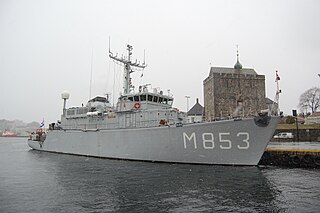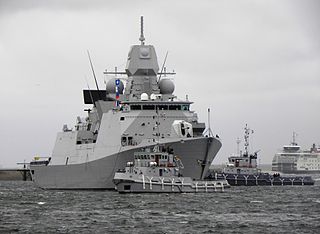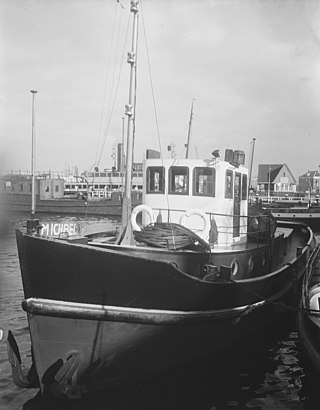
The Alkmaar class is a ship class of fifteen minehunters that were built in the Netherlands for the Royal Netherlands Navy. They are based on the design of the Tripartite class, which was developed by a collaborative effort between the Netherlands, Belgium and France, and replaced the minesweepers and minehunters of the Dokkum class.

The Roofdier class was a class of six frigates that were built in the United States as Patrol Craft Escorts (PCE) for the Netherlands. The frigates were loaned to the Royal Netherlands Navy as part of the Mutual Defense Assistance Act (MDAP) and from 1954 to 1984 served as the Roofdier-class frigates.
The Buyskes class was a class of two hydrographic survey vessels that were part of the Dutch Hydrographic Service of the Royal Netherlands Navy. Together with HNLMS Tydeman the ships of this class were the main ships of the Dutch Hydrographic Service during the last quarter of the 20th century. While the ships of the Buyskes class were built for performing hydrographic research, the Tydeman was focused on oceanography.

The Van Straelen class was a ship class of sixteen minesweepers that were built in the Netherlands for the Royal Netherlands Navy (RNN). They were taken into service of the RNN between 1960 and 1962 and served until 1 March 1983.
The Beemster-class was a class of fourteen minesweepers that were built at different shipyards in the United States for the Royal Netherlands Navy (RNN). The minesweepers were based on the AMS-60 design and paid for by the United States under the Mutual Defense Assistance Program (MDAP). The minesweepers served in the RNN between 1953 and 1976.

The Linge class are a series of tugboats used by the Royal Netherlands Navy to dock their larger ships at the Nieuwe Haven Naval Base.

The Balder-class patrol vessels were a class of five patrol vessels built for the Royal Netherlands Navy in the 1950s at the Rijkswerf in Willemsoord, Den Helder. They were paid for by the United States under the Mutual Defense Assistance Program (MDAP). The ships were used to patrol the Dutch coast and waterways.

The Dokkum class was a ship class of eighteen minesweepers that were built in the Netherlands for the Royal Netherlands Navy. They were paid for by the United States under the Mutual Defense Assistance Program (MDAP).

The Onversaagd class was a ship class of six minesweepers that were built in the United States for the Royal Netherlands Navy (RNN). They were paid for by the United States under the Mutual Defense Assistance Program (MDAP). The minesweepers were based on the design of the Aggressive class and taken into service of the RNN between 1954 and 1955.

The Borndiep-class was a ship class of 10 minesweepers that served between 1946 and 1962 in the Royal Netherlands Navy (RNN). They were former British Yard Mine Sweepers (BYMS) that were transferred from the Royal Navy to the RNN in 1946.
HNLMS Wamandai (A870) was a tugboat of the Royal Netherlands Navy (RNN). She was built in the Netherlands and served between 1962 and 1985 in the RNN.
HNLMS Thetis (A887) was a accommodation ship of the Royal Netherlands Navy. It was used as a diving and disassembly school.
HNLMS Wambrau (A871) was a tugboat of the Royal Netherlands Navy (RNN). She served in the RNN between 1957 and 1987.

HNLMS Orkaan (A837) was a tugboat of the Royal Netherlands Navy (RNN). She served in the RNN between 1949 and 1961. It was at the time the largest tugboat to be built in the Netherlands for the RNN.
The P 1-class was a ship class of four patrol vessels that were built at the Marine Etablissement te Soerabaja in the Dutch East Indies. They were the first patrol vessels that were built in the Dutch East Indies for the Royal Netherlands Navy.

HNLMS Johan Maurits van Nassau (F802) was a River-class frigate of the Royal Netherlands Navy (RNN). She was built in the United Kingdom originally for the Royal Navy as HMS Ribble, however, during the construction the frigate was acquired by the RNN. She served in the RNN between 1943 and 1958.

HNLMS Zeefakkel was a hydrographic survey vessel built in the Netherlands for the Royal Netherlands Navy. She was specially designed to perform surveys in coastal areas and did this between 1951 and 1972. Later she was turned into a training vessel.

The Dreg I class was a ship class of four hydrographic survey vessels that were built in the Netherlands for the Royal Netherlands Navy (RNN). They served in the RNN between 1950 and 1986.

HNLMS Jan van Brakel was a minelayer and patrol vessel of the Royal Netherlands Navy (RNN). She was built in the Netherlands and served in the RNN between 1936 and 1957.
The Ram class was a ship class of two minelayers built in the Dutch East Indies for the Government Navy. However, before the minelayers could be completed the Dutch East Indies was invaded by the Japanese. As a result, the ships were completed as gunboats by the Japanese and taken into service of the Imperial Japanese Navy.













